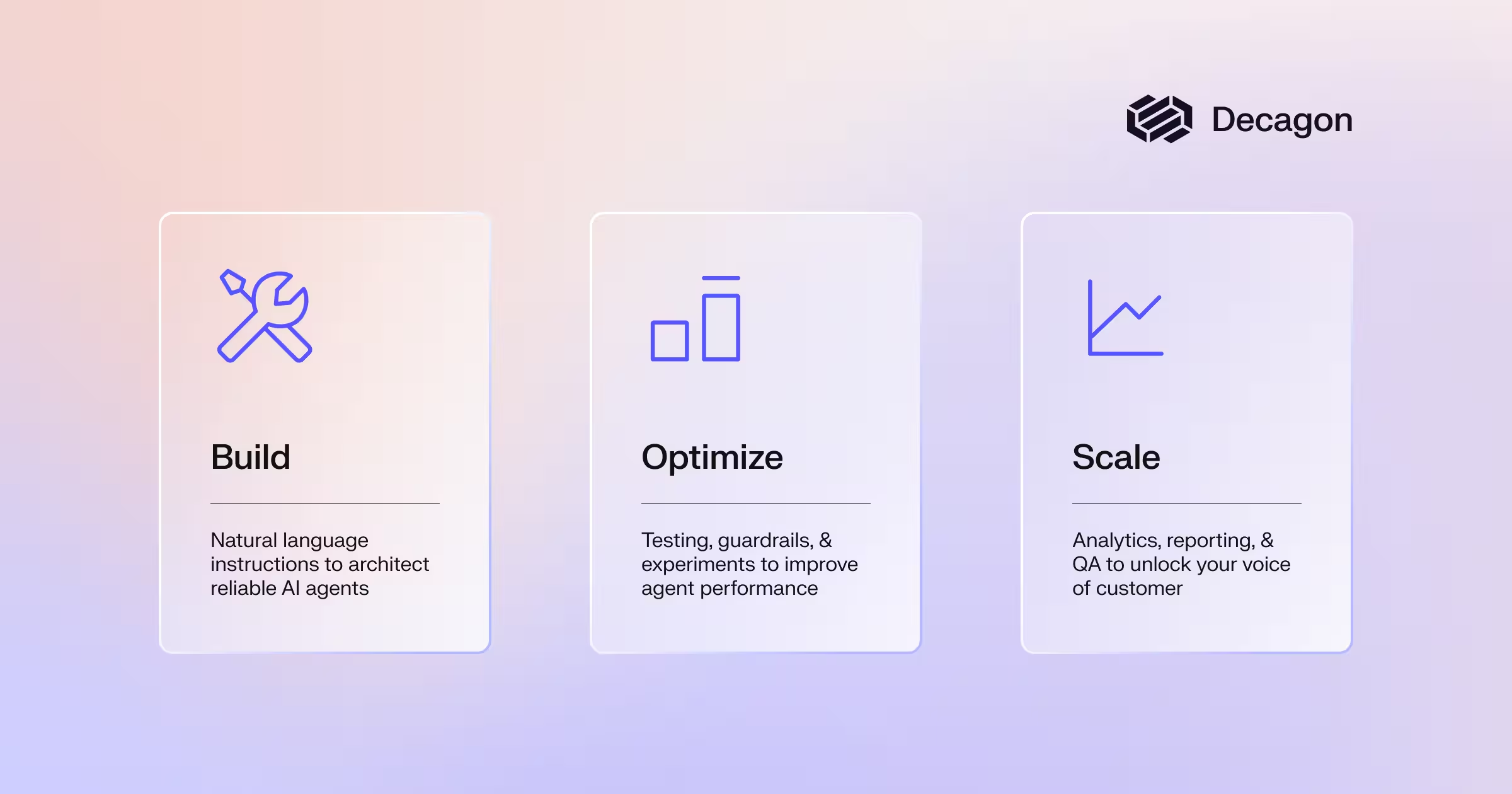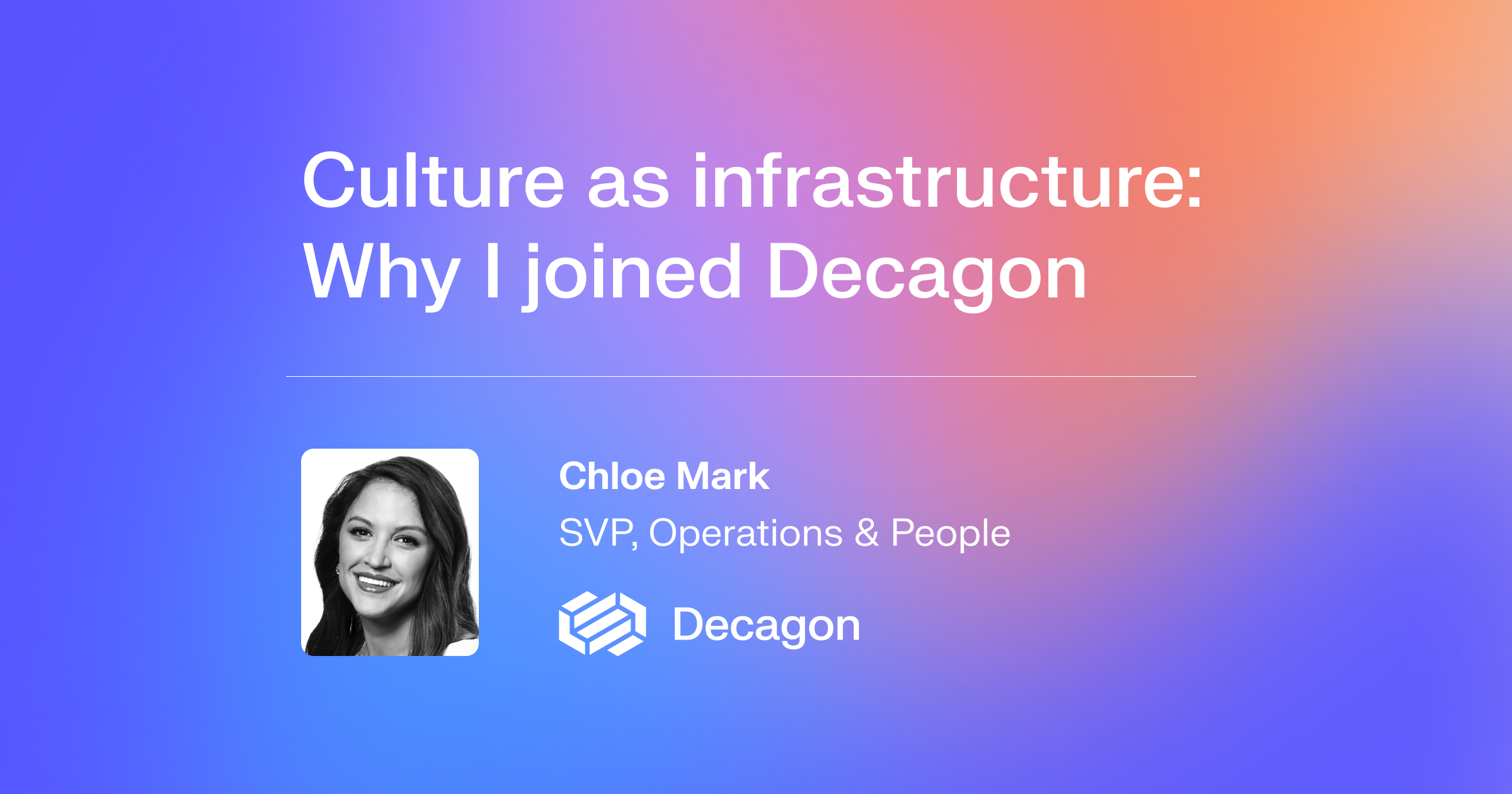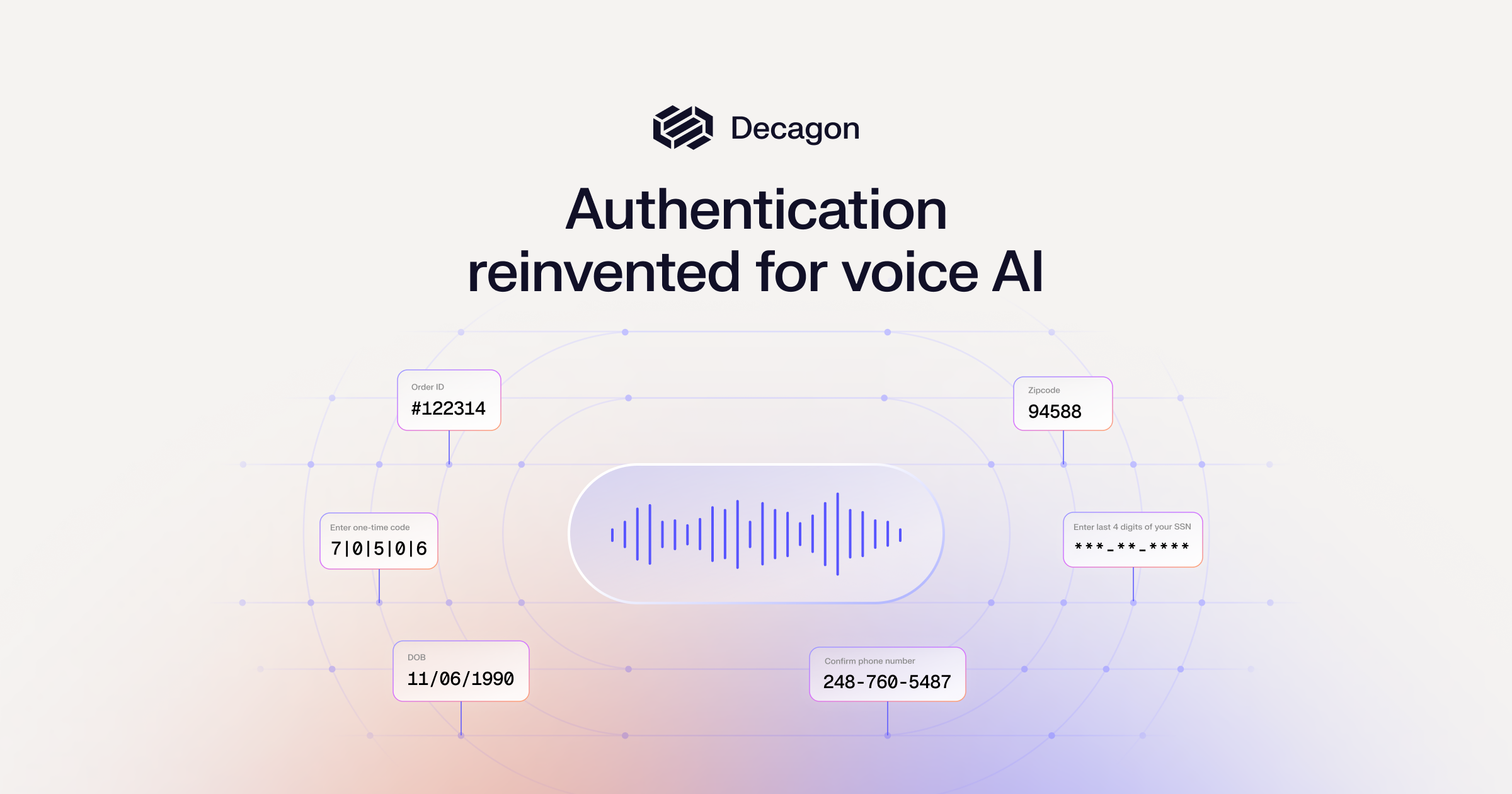The case for a unified, transparent platform in conversational AI
Decagon provides a different path with a single, AI-native platform that unifies development, testing, analytics, and deployment.

Building and managing AI agents today often feels like assembling a jigsaw puzzle. Many teams start with a promising model and then stitch together a patchwork of orchestration layers, testing frameworks, and analytics dashboards in hopes of creating something cohesive. These internal builds offer control, but they’re expensive to maintain, brittle in production, and slow to evolve.
On the other side are platforms that promise speed but fall short on completeness. They often lack the deep testing, analytics, and observability needed to operate real AI systems at scale. You end up with a black box that can’t be trusted or improved.
Decagon provides a different path with a single, AI-native platform that unifies development, testing, analytics, and deployment, bringing product, CX, and engineering teams together around one shared source of truth.
This is what a unified platform looks like in practice:
- Build your agent with natural language through Agent Operating Procedures (AOPs).
- Optimize performance with automated simulations, guardrails, and live experimentation.
- Scale intelligently using analytics, insights, and self-improving knowledge systems.
- Deploy across chat, voice, and email with shared memory and context across channels.

Build your agent
At the heart of our platform are Agent Operating Procedures (AOPs) — natural language instructions that compile into structured logic for agents to reliably execute workflows. AOPs let teams teach their agents the same way they’d onboard a new teammate, describing what to do, how to do it, and under what conditions to adapt. The result is human-readable, machine-executable reliability.
This approach eliminates the friction of traditional coding-heavy SDKs that function as black boxes for business users. CX and product teams can directly design, test, and refine agent behavior without asking for engineering resources or relying on expensive professional services. At the same time, AOPs give technical teams full control over how the agent operates under the hood. They can:
- Write tools that extend AOPs by triggering actions in core systems (CRM, billing, fulfillment, etc.)
- Integrate internal knowledge bases to inform the agent’s reasoning and ticketing systems and CCaaS platforms to seamlessly escalate conversations when needed
- Manage version control via Git and connect to custom alerting tools like PagerDuty, Slack, or email
Unlike other natural language offerings that are limited to simpler use cases, AOPs are built to support complex, multi-turn workflows with enterprise-grade reliability. They ensure every step is executed in sequence, every dependency is handled correctly, and every outcome is traceable, even in highly dynamic scenarios. This reliability is powered by a collection of LLMs working in coordination, each responsible for interpreting, reasoning, and validating different parts of the workflow to guarantee precision and consistency at scale.
That balance of flexibility and structure gives teams the best of both worlds: the agility of natural language and the rigor of engineered systems.
Optimize your agent
Building an AI agent is just the beginning. The real challenge is making sure it performs consistently, safely, and intelligently once it meets the real world. Many solutions focus on getting agents live, but few provide comprehensive tooling to continuously test, refine, and improve them.
Optimizing your agent starts with simulations. Before an agent ever talks to a customer, Decagon automatically generates realistic conversations from mock users to test its behavior. Teams can define custom personas or upload real transcripts to generate them automatically, then evaluate each exchange against clear success criteria. The results reveal where logic breaks down, tone drifts, or reasoning falters, with full traceability and observability to map what to fix before production.
Decagon layers built-in and customizable guardrails to keep agents safe and predictable once they're in production. Automatic checks like hallucination detection and bad-actor filtering work alongside escalation rules for sensitive topics. These guardrails turn reliability from something you hope for into something you can design, observe, and count on.
When your agent is stable, the focus shifts to experiments. Decagon’s experimentation suite lets teams run controlled A/B tests across live customer conversations to compare variations in tone, logic, or knowledge. You can measure how each change affects metrics like CSAT and deflection rate, visualize results and statistical significance in curated dashboards, and gradually roll out improvements with confidence.
Together, simulations, observability, guardrails, and experimentation create a feedback loop that helps every agent become smarter, safer, and more effective over time. Teams can now optimize their agents with the same rigor they apply to any other core product, moving from one-off deployments to continuously improving systems.
Scale your agent
Once an agent is live, scaling it isn’t just about handling more conversations. Most platforms offer little visibility into how agents actually perform or where customers struggle, particularly when conversation outcomes are tied to pricing. Decagon was built with transparency as a primary focus.
Our insights & reporting suite gives teams a clear view of customer interactions and agent performance. Dashboards surface key outcomes, sentiment shifts, and topic trends, with granular filters to drill into specific conversations. Teams can measure important metrics like CSAT and deflection, pinpoint friction points, and feed those insights directly into optimization workflows. To go deeper, Ask AI turns analytics into conversation, letting teams ask questions like “What’s driving CSAT down this week?” and get instant, data-backed answers.
Beyond opinionated reporting, Decagon provides Watchtower to deliver continuous, always-on monitoring and QA across every conversation. Teams can define flagging criteria in plain language and automatically review interactions against those standards, whether to monitor compliance, sentiment, or tone. Powered by contextual understanding rather than simplistic keyword matches, Watchtower distinguishes real risks from noise and surface issues early for CX, product, and engineering teams.
Finally, knowledge suggestions ensure your agent keeps learning. It analyzes where the agent struggles, identifies the root knowledge gap, and recommends updates to your help center or documentation. It can even draft articles automatically, modeled on how your top human agents resolve similar cases. Over time, your knowledge base becomes self-correcting, always adapting to real customer needs.
Decagon’s analytical features turn every interaction into data, every failure into feedback, and every conversation into a source of truth for the voice of your customer. Most tools stop when the conversation ends; Decagon begins there, building the systems for AI that truly improve with scale.
Deploy your agent
Customer conversations don’t happen in one place; they move fluidly across chat, voice, email, and beyond. Most AI platforms treat those as separate systems, forcing teams to rebuild logic or sacrifice context with every new channel.
With Decagon, you can build your agent’s logic once and deploy it everywhere. Every channel, whether chat, voice, email, SMS, or any custom surface, draws on the same underlying intelligence and shared memory. That means an agent can pick up where a customer left off, regardless of where the next interaction happens.
This unified architecture delivers consistency for customers and efficiency for teams. There’s no duplication of logic, no retraining, and no fragmented analytics. Instead, every channel becomes another extension of the same intelligence that remembers, reasons, and responds in context.
Unifying the agent lifecycle
The future of customer experience AI won’t be defined by point solutions or clever model wrappers. It will be led by platforms that unify the entire lifecycle — building, testing, scaling, and deployment — into one transparent system.
That’s why Decagon provides a unified, AI-native platform where product, CX, and engineering teams work from the same foundation. Every conversation becomes a source of learning and insight, and every agent gets smarter over time.
Book a demo today to see the platform in action and learn how Decagon can elevate your customer experience.
The case for a unified, transparent platform in conversational AI
October 22, 2025

Building and managing AI agents today often feels like assembling a jigsaw puzzle. Many teams start with a promising model and then stitch together a patchwork of orchestration layers, testing frameworks, and analytics dashboards in hopes of creating something cohesive. These internal builds offer control, but they’re expensive to maintain, brittle in production, and slow to evolve.
On the other side are platforms that promise speed but fall short on completeness. They often lack the deep testing, analytics, and observability needed to operate real AI systems at scale. You end up with a black box that can’t be trusted or improved.
Decagon provides a different path with a single, AI-native platform that unifies development, testing, analytics, and deployment, bringing product, CX, and engineering teams together around one shared source of truth.
This is what a unified platform looks like in practice:
- Build your agent with natural language through Agent Operating Procedures (AOPs).
- Optimize performance with automated simulations, guardrails, and live experimentation.
- Scale intelligently using analytics, insights, and self-improving knowledge systems.
- Deploy across chat, voice, and email with shared memory and context across channels.

Build your agent
At the heart of our platform are Agent Operating Procedures (AOPs) — natural language instructions that compile into structured logic for agents to reliably execute workflows. AOPs let teams teach their agents the same way they’d onboard a new teammate, describing what to do, how to do it, and under what conditions to adapt. The result is human-readable, machine-executable reliability.
This approach eliminates the friction of traditional coding-heavy SDKs that function as black boxes for business users. CX and product teams can directly design, test, and refine agent behavior without asking for engineering resources or relying on expensive professional services. At the same time, AOPs give technical teams full control over how the agent operates under the hood. They can:
- Write tools that extend AOPs by triggering actions in core systems (CRM, billing, fulfillment, etc.)
- Integrate internal knowledge bases to inform the agent’s reasoning and ticketing systems and CCaaS platforms to seamlessly escalate conversations when needed
- Manage version control via Git and connect to custom alerting tools like PagerDuty, Slack, or email
Unlike other natural language offerings that are limited to simpler use cases, AOPs are built to support complex, multi-turn workflows with enterprise-grade reliability. They ensure every step is executed in sequence, every dependency is handled correctly, and every outcome is traceable, even in highly dynamic scenarios. This reliability is powered by a collection of LLMs working in coordination, each responsible for interpreting, reasoning, and validating different parts of the workflow to guarantee precision and consistency at scale.
That balance of flexibility and structure gives teams the best of both worlds: the agility of natural language and the rigor of engineered systems.
Optimize your agent
Building an AI agent is just the beginning. The real challenge is making sure it performs consistently, safely, and intelligently once it meets the real world. Many solutions focus on getting agents live, but few provide comprehensive tooling to continuously test, refine, and improve them.
Optimizing your agent starts with simulations. Before an agent ever talks to a customer, Decagon automatically generates realistic conversations from mock users to test its behavior. Teams can define custom personas or upload real transcripts to generate them automatically, then evaluate each exchange against clear success criteria. The results reveal where logic breaks down, tone drifts, or reasoning falters, with full traceability and observability to map what to fix before production.
Decagon layers built-in and customizable guardrails to keep agents safe and predictable once they're in production. Automatic checks like hallucination detection and bad-actor filtering work alongside escalation rules for sensitive topics. These guardrails turn reliability from something you hope for into something you can design, observe, and count on.
When your agent is stable, the focus shifts to experiments. Decagon’s experimentation suite lets teams run controlled A/B tests across live customer conversations to compare variations in tone, logic, or knowledge. You can measure how each change affects metrics like CSAT and deflection rate, visualize results and statistical significance in curated dashboards, and gradually roll out improvements with confidence.
Together, simulations, observability, guardrails, and experimentation create a feedback loop that helps every agent become smarter, safer, and more effective over time. Teams can now optimize their agents with the same rigor they apply to any other core product, moving from one-off deployments to continuously improving systems.
Scale your agent
Once an agent is live, scaling it isn’t just about handling more conversations. Most platforms offer little visibility into how agents actually perform or where customers struggle, particularly when conversation outcomes are tied to pricing. Decagon was built with transparency as a primary focus.
Our insights & reporting suite gives teams a clear view of customer interactions and agent performance. Dashboards surface key outcomes, sentiment shifts, and topic trends, with granular filters to drill into specific conversations. Teams can measure important metrics like CSAT and deflection, pinpoint friction points, and feed those insights directly into optimization workflows. To go deeper, Ask AI turns analytics into conversation, letting teams ask questions like “What’s driving CSAT down this week?” and get instant, data-backed answers.
Beyond opinionated reporting, Decagon provides Watchtower to deliver continuous, always-on monitoring and QA across every conversation. Teams can define flagging criteria in plain language and automatically review interactions against those standards, whether to monitor compliance, sentiment, or tone. Powered by contextual understanding rather than simplistic keyword matches, Watchtower distinguishes real risks from noise and surface issues early for CX, product, and engineering teams.
Finally, knowledge suggestions ensure your agent keeps learning. It analyzes where the agent struggles, identifies the root knowledge gap, and recommends updates to your help center or documentation. It can even draft articles automatically, modeled on how your top human agents resolve similar cases. Over time, your knowledge base becomes self-correcting, always adapting to real customer needs.
Decagon’s analytical features turn every interaction into data, every failure into feedback, and every conversation into a source of truth for the voice of your customer. Most tools stop when the conversation ends; Decagon begins there, building the systems for AI that truly improve with scale.
Deploy your agent
Customer conversations don’t happen in one place; they move fluidly across chat, voice, email, and beyond. Most AI platforms treat those as separate systems, forcing teams to rebuild logic or sacrifice context with every new channel.
With Decagon, you can build your agent’s logic once and deploy it everywhere. Every channel, whether chat, voice, email, SMS, or any custom surface, draws on the same underlying intelligence and shared memory. That means an agent can pick up where a customer left off, regardless of where the next interaction happens.
This unified architecture delivers consistency for customers and efficiency for teams. There’s no duplication of logic, no retraining, and no fragmented analytics. Instead, every channel becomes another extension of the same intelligence that remembers, reasons, and responds in context.
Unifying the agent lifecycle
The future of customer experience AI won’t be defined by point solutions or clever model wrappers. It will be led by platforms that unify the entire lifecycle — building, testing, scaling, and deployment — into one transparent system.
That’s why Decagon provides a unified, AI-native platform where product, CX, and engineering teams work from the same foundation. Every conversation becomes a source of learning and insight, and every agent gets smarter over time.
Book a demo today to see the platform in action and learn how Decagon can elevate your customer experience.





